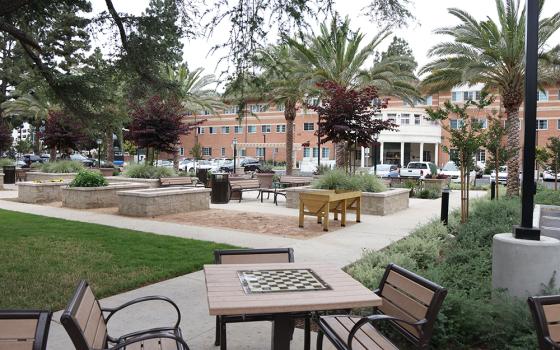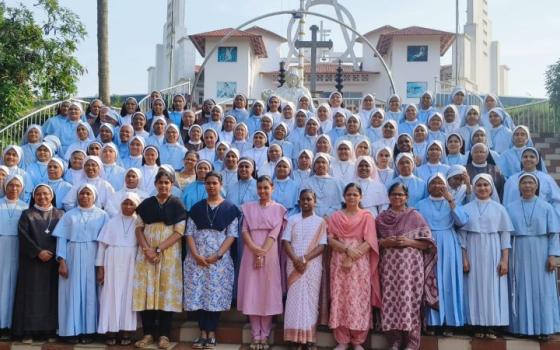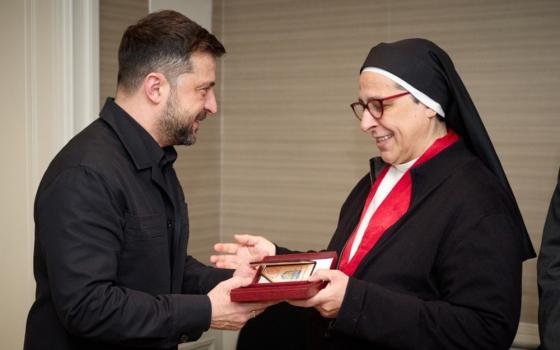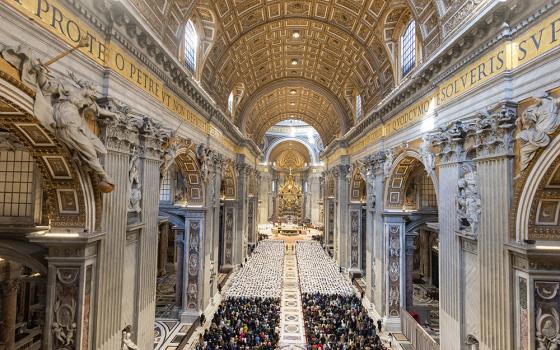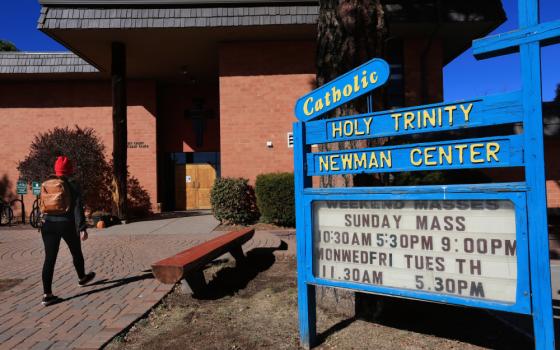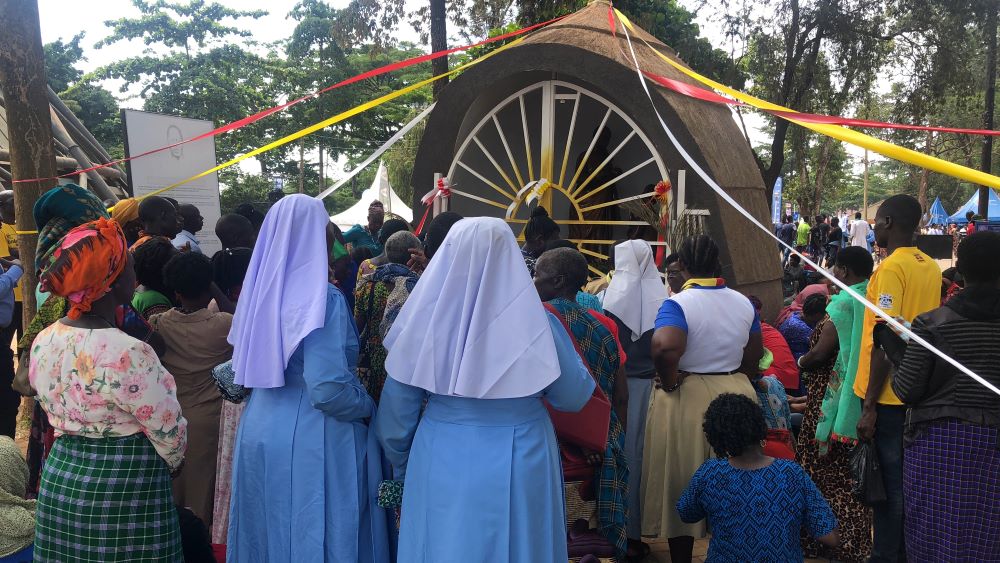
Catholic sisters in blue habits stand alongside other pilgrims as they face the shrine of St. Charles Lwanga at Namugongo. Ribbons in papal colors — white, yellow and red — decorate the site as thousands visit to commemorate the courage and sacrifice of the Uganda martyrs. (GSR photo/Gerald Matembu)
Singing hymns and waving palm branches, barefoot pilgrims flooded the Uganda Martyrs Shrine at Namugongo on June 2. They completed long, dusty treks from across East Africa to honor the Uganda martyrs, 22 young Catholic converts executed in the late 19th century for refusing to renounce their faith.
The annual pilgrimage, held June 3, has grown into one of the largest religious gatherings on the African continent. But this year, under the new papacy of Pope Leo XIV — the first U.S. pontiff and a champion for the church's marginalized — the celebrations took on renewed urgency and global resonance.
"In Pope Leo, we see someone who understands the church in Africa and respects our witness," said Sr. Edgalda Tumwichirize of the Little Sisters of St. Francis of Assisi, who walked over 50 miles from her convent in central Uganda. "The Uganda martyrs remind us to stand firm in truth and justice, even at great cost. Their story speaks to the whole world."
From 1885 to 1887, King Mwanga II of Buganda ordered the execution of dozens of young Christian converts, including the 22 now-sainted Catholic martyrs, many of them teenagers. Their deaths galvanized Catholic missions across Africa, and their memory continues to inspire generations of believers.
This year's Martyrs Day was marked by the theme: "Pilgrim of Hope — Oh Lord, Let Me See Again," drawing connections between the martyrs' courage and today's struggles with injustice, poverty and exclusion.
A message that resonates
Fr. Paul Ebwolu of Soroti Catholic Diocese in Eastern Uganda said Leo's call for the global church to rediscover the spiritual wealth of peripheral communities had deeply resonated with many in Uganda.
"We feel truly seen," Ebwolu said. "For a long time, Africa has been viewed as merely a source of vocations and numbers. Now, our faith story is finally being recognized as central to the church's future."
Throughout the week leading to June 3, Namugongo hosted a flurry of events: candlelight processions, youth forums, interfaith dialogues and nightly open-air Masses that drew thousands of pilgrims. Choirs performed traditional hymns, while catechists told the story of the martyrs with moving dramatizations.
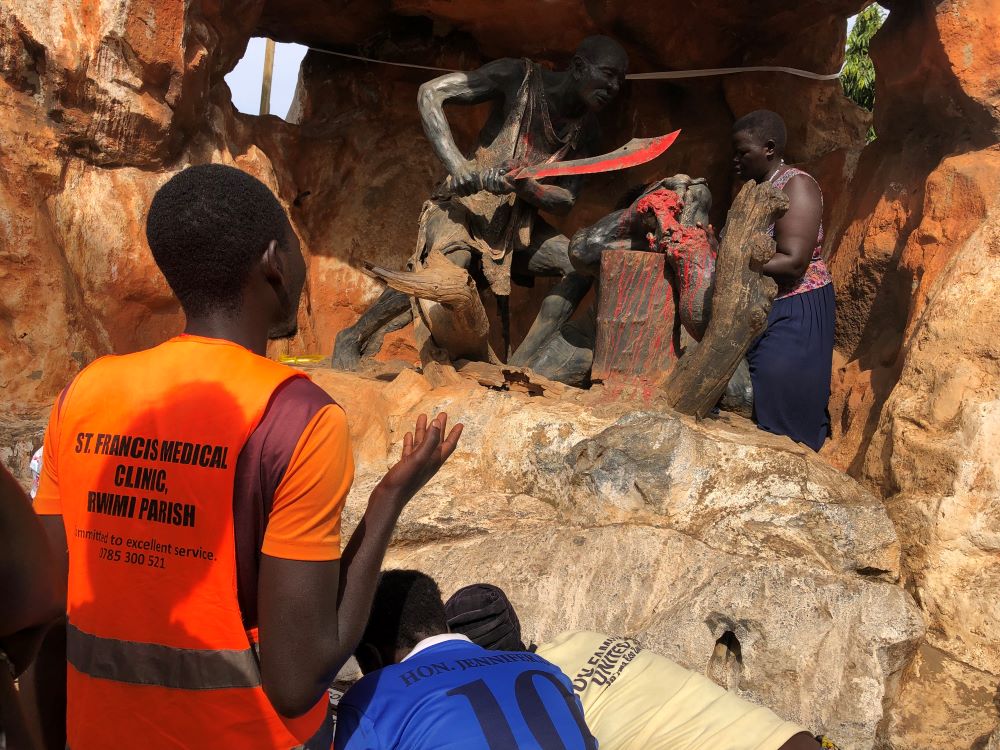
A pilgrim prays in front of a sculpture depicting the brutal execution of a Uganda martyr, part of the Stations of the Martyrs at Namugongo. An estimated 2 million people participated in a pilgrimage to the Uganda Martyrs Shrine at Namugongo to honor the suffering of Christian converts under King Mwanga's regime. (GSR photo/Gerald Matembu)
"This place represents the kind of witness that Pope Leo is calling for — a witness grounded in humility, resistance to injustice, and deep love for Christ," said Sr. Mary Salome Aguti, who walked over 150 miles from her convent in Eastern Uganda.
The novena leading to Martyrs Day included special prayers for peace in global conflict zones, notably Ukraine and Gaza, echoing Leo's recent appeals for global solidarity with the suffering.
Local religious leaders hope Leo will soon follow in the footsteps of his predecessors: Popes Paul VI, John Paul II and Francis all visited Namugongo, underscoring the shrine's global importance.
Ebwolu said a visit from Leo would affirm the significance of African Catholicism. "It would be a sign that martyrdom is not just a memory, but a living reality and challenge," he said.
Organizers estimate more than 2 million pilgrims gathered this year, including visitors from Tanzania, Rwanda, South Africa, Nigeria, the Democratic Republic of Congo, and even Brazil and Canada.
The influx has overwhelmed roads, sanitation and security systems, sparking renewed calls for international support for religious infrastructure in Africa.
'We feel truly seen. For a long time, Africa has been viewed as merely a source of vocations and numbers. Now, our faith story is finally being recognized as central to the church's future.'
—Fr. Paul Ebwolu
"This shrine is a gift to the universal church," said Sr. Grace Angelina Aciro, superior general of the Little Sisters of Mary Immaculate of Gulu. "It tells a story that must not be forgotten. These young men converted not just with words, but through their sacrifice. That witness evangelizes even now."
Aciro emphasized the importance of unity in diversity. "The martyrs transcended tribal and regional divides. That's the message the global church must hear: We are one people of God," she said.
She said the martyrs' legacy is also a model for youth and church leaders today. "They were united in the Lord despite their differences. That's a powerful message for our world today, which is so divided."
Aligning with Pope Leo's vision
For many younger pilgrims, Leo's emphasis on social justice, environmental care and inclusion feels deeply aligned with the martyrs' legacy.
"Our ancestors resisted corruption and abuse. Today, we must resist the same forces — not with weapons, but with holiness," said Moses Amani, a pilgrim from Bungoma in Western Kenya. He also praised the Holy Father's vision for a stronger and more influential African Church.
Ebwolu echoed the sentiment: "This is the global church. It lives not just in Rome, but in the dust, in the songs, and in the faith of people who still believe."
As Namugongo continues to rise in global stature, many see it as a guiding light for the church's future.
"Pope Leo XIV is inviting us to reimagine Catholicism: inclusive, resilient, grounded in the suffering and hope of the Global South," Ebwolu said. "Namugongo can help lead the way."
Advertisement
Aciro urged the Vatican to deepen engagement with Africa's spiritual heritage. "If we are serious about inclusivity, African voices must be heard — not just listened to," she said.
She called for expanded roles for African theologians, women religious and young Catholics in global church dialogues and decision-making processes.
"When we share the story of the Uganda martyrs with the world — with youth and elders alike — we offer something powerful," Aciro said. "It is through inculturation, without prejudice, that we can truly live the unity Pope Leo XIV envisions."
She added, "Namugongo is not just a historical site. It is a living, breathing witness to our faith. And it shows the world what the African church has to offer."
As the final hymns faded into the twilight, the spirit of the martyrs lingered — a solemn reminder that faith, courage, and hope can endure even in the face of death. This year's Uganda Martyrs Day celebration was led by Bishop Christopher Kakooza of Lugazi Diocese, who organized a 500-member choir to animate the liturgy.
"The martyrs spoke with their lives," said Sr. Jane Harriet Nansubuga of the Little Sisters of St. Francis. She serves as head teacher of Stella Maris Primary School, whose pupils were among those leading the choir.
"Now it is our turn to answer with how we live."


